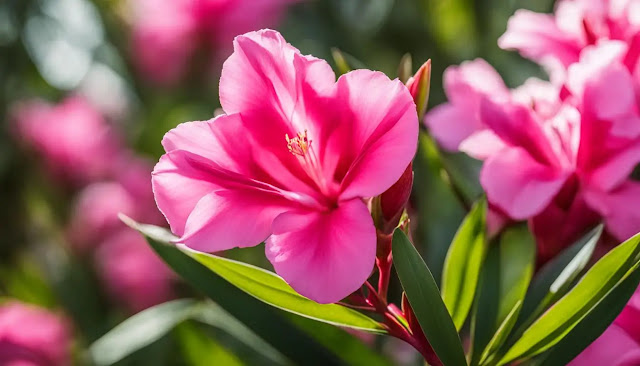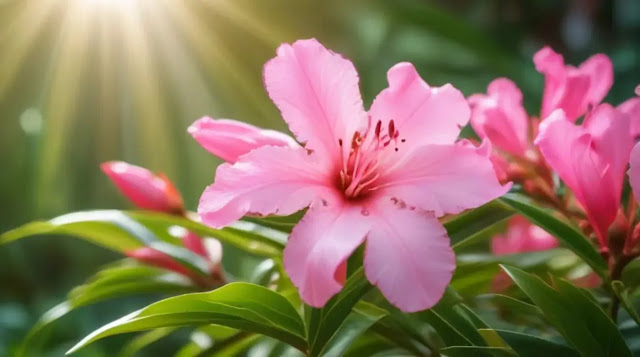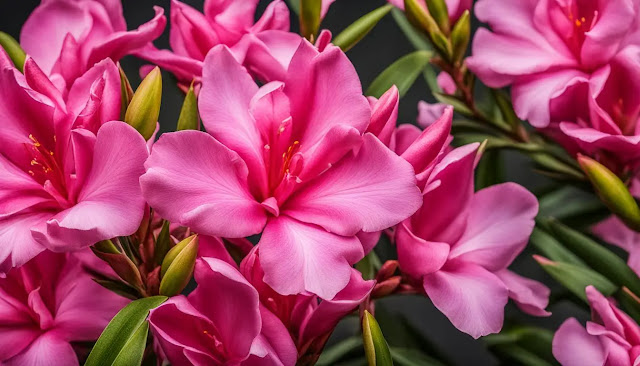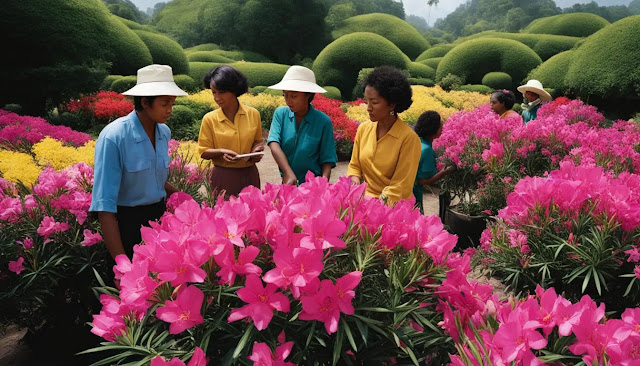 |
| oleander flower meaning |
Have you ever wondered about the deeper meaning behind flowers? Beyond their beauty, many flowers hold symbolic significance and possess healing properties. One such flower that intrigues both flower enthusiasts and spiritual seekers is the oleander. But what is the spiritual symbolism of the oleander flower? And are there any healing benefits associated with it?
In this article, we will delve into the fascinating world of the oleander flower, exploring its spiritual symbolism and uncovering its potential healing properties. From its diverse cultural meanings to its role in modern urban landscapes, we will unravel the enigmatic nature of the oleander flower and shed light on its abundant benefits.
- Explore the spiritual symbolism behind the oleander flower
- Discover the potential healing properties of the oleander flower
- Uncover the cultural significance of the oleander flower through the ages
- Learn about the botanical science behind the oleander plant
- Examine the role of oleander in modern urban landscapes
The Enigmatic Nature of Oleander: Understanding the Flower’s Meaning
The enigmatic nature of the oleander flower has long intrigued and fascinated people around the world. It is a flower that holds deep symbolism and meaning, transcending its sheer beauty. In this section, we will dive into the spiritual symbolism behind the oleander flower, explore its meaning across different cultures, and discover why it is more than just a beautiful flower.
Spiritual symbolism behind the oleander flower
The oleander flower has significant spiritual symbolism associated with it. It is often seen as a symbol of love, representing romance, desire, and passion. The flower's vibrant colors and delicate petals evoke feelings of intense emotions and strong affection. Moreover, the oleander is believed to possess protective qualities, guarding against negative energies and warding off evil spirits.
Furthermore, the oleander flower is associated with transformation and rebirth. Its ability to withstand harsh conditions and thrive in adversity is seen as a metaphor for personal growth and resilience. The flower's symbolization of transformation makes it a powerful emblem for those seeking to overcome challenges and embrace change in their lives.
Unpacking the oleander flower meaning across cultures
The meaning of the oleander flower varies across cultures, adding to its enigmatic nature. In Greek mythology, the oleander is linked to the tragic love story of Hero and Leander, representing eternal love and sacrifice. In other cultures, the oleander is seen as a symbol of femininity, beauty, and elegance.
Religions also attribute significance to the oleander flower. In Hinduism, the oleander is associated with the goddess Durga and is used in religious ceremonies to invoke protection and blessings. In Christianity, the oleander is often seen as a symbol of purity and beauty, representing the Virgin Mary.
Why the oleander is more than just a beautiful flower
While the oleander flower's beauty is undeniable, its allure extends beyond its aesthetic appeal. The flower's enigmatic nature and rich symbolism have captured the interest of botanists, artists, and enthusiasts alike, making it a subject of fascination and exploration.
Furthermore, the oleander flower holds practical value beyond its symbolic meanings. Its medicinal properties have long been recognized, with traditional medicine incorporating oleander in various treatments. However, it is crucial to note that while the oleander has potential healing benefits, it is also highly toxic if ingested, emphasizing the duality of this extraordinary flower.
Exploring the Cultural Significance of Oleander Through Ages
 |
| oleander in ancient myth |
In this section, we will explore the cultural significance of the oleander flower throughout history. Oleander, with its enchanting beauty and rich symbolism, has left a lasting impact on various aspects of human culture.
The oleander in ancient myth: From the shores calling “oh Leander” to Jericho
Ancient myths and legends have often featured the oleander flower, rendering it a symbol of love, passion, and tragedy. One well-known tale is the story of Leander and Hero, where the oleander represents Leander's enduring love and the dangers he faces while swimming across the Hellespont to be with his beloved. Another ancient tale connects oleander to the ancient city of Jericho.
How oleander festivals celebrate the plant's historical impact
Oleander festivals have become a way to celebrate the historical impact of this beloved flower. These festivals, held in various parts of the world, pay homage to the cultural significance of oleander and its role in local traditions and customs. They often feature parades, music, dance, and exhibits showcasing the diverse beauty and symbolism associated with oleander.
Oleander-themed artworks and their meanings
The allure of the oleander flower has inspired countless artists throughout history. From paintings to sculptures, oleander-themed artworks capture the ethereal beauty and symbolic depth of this flower. Artists depict the oleander in various ways, exploring its themes of love, femininity, and transformation. The meanings behind these artworks can range from representing the fragility of life to the celebration of beauty amidst adversity.
The Oleander Plant in Botanical Science: A Noun Among Flowers
 |
| nerium oleander |
In this section, we will explore the oleander plant from a botanical science perspective. Nerium oleander, commonly known as oleander, is an evergreen shrub belonging to the dogbane family, Apocynaceae. This majestic plant is renowned for its beautiful flowers and its intriguing medicinal and poisonous properties.
Nerium oleander: An evergreen shrub of the dogbane family, Apocynaceae
Nerium oleander, also called oleander, is a fascinating evergreen shrub that belongs to the dogbane family, Apocynaceae. Native to the Mediterranean region, this plant is cherished for its lush foliage and captivating flowers that bloom in vibrant colors, including shades of pink, white, red, and yellow. With its stunning appearance and unique characteristics, nerium oleander has captivated the attention of botanists, gardeners, and flower enthusiasts worldwide.
The medicinal and poisonous dichotomy of oleander
One of the most intriguing aspects of the oleander plant is its dual nature as both a medicinal herb and a highly poisonous plant. While various parts of the oleander plant, such as leaves, stems, and flowers, have been used in traditional medicine for centuries, it's important to note that oleander contains toxic substances known as cardiac glycosides. These compounds, including oleandrin and nerioside, can be lethal if ingested in large quantities. However, when used correctly and under professional guidance, certain extracts derived from oleander have shown potential therapeutic benefits, particularly in the field of cancer research.
Key characteristics that set the nerium plant apart from others
| Characteristics | Description |
|---|---|
| Flower | The nerium plant produces clusters of showy flowers with five petals, exhibiting a wide range of colors from pink to white, red, and yellow. |
| Foliage | The leaves of the oleander plant are long, narrow, and leathery, arranged in an alternate pattern along the stems. |
| Growth Habit | Oleander is an evergreen shrub that can reach heights of up to 20 feet. Its growth habit is dense and bushy, making it a popular choice for hedges and ornamental landscaping. |
| Hardiness | The nerium plant is known for its resilience and adaptability to various climatic conditions. It can tolerate drought, high temperatures, and poor soil quality. |
| Propagation | Oleander can be propagated through methods such as stem cuttings and seed germination. It is a relatively easy plant to propagate, making it accessible to both amateur and professional gardeners. |
These key characteristics set the nerium plant apart from other plants, contributing to its distinct beauty and resilience.
Oleander's Role in Modern Urban Landscapes
 |
| oleander in urban landscapes |
The oleander flower plays a significant role in enhancing the beauty and vibrancy of modern urban landscapes. With its hardy nature and stunning blossoms, oleander has become a popular choice for city landscaping.
Why oleander is a popular choice for city landscaping
Oleander's popularity in cities stems from its ability to thrive in urban environments. This flowering shrub is known for its tolerance to pollution, drought, and heat, making it well-suited for city life. It can adapt to a variety of soil types and requires minimal maintenance, making it an ideal choice for busy urban areas.
In addition to its resilience, the oleander flower's aesthetic appeal is another reason for its popularity. With its showy blooms ranging in colors from white and pink to red and yellow, oleander adds a touch of vibrant beauty to city streets, parks, and gardens.
Oleander City: How this flower became the official flower of cities
Oleander's popularity in cities has led to its designation as the official flower of many urban areas. This recognition of the flower's beauty and significance has turned some cities into literal "Oleander Cities," where the flower is celebrated and showcased.
For example, the city of Wilmington in California, USA, has embraced the oleander as its official flower and hosts an annual Oleander Festival to honor its symbolic value. These festivals often feature parades, art displays, and various activities centered around the oleander flower, further reinforcing its importance in urban landscapes.
The practical benefits of planting oleander in urban areas
Beyond its aesthetic appeal and symbolic value, planting oleander in urban areas offers practical benefits. One notable advantage is the plant's ability to reduce air pollution. Oleander foliage can absorb pollutants from the atmosphere, helping to improve air quality in urban environments.
Furthermore, oleander's extensive root system helps prevent soil erosion in areas with high foot traffic or heavy rainfall. The dense network of roots stabilizes the soil and reduces the risk of erosion, making oleander a valuable asset in landscaping projects.
Overall, the allure of oleander in urban landscapes is undeniable. Its impressive resilience, captivating beauty, and practical benefits make it a standout choice for city landscaping projects.
Contributions of International Oleander Societies to Plant Conservation
The Mission and Work of the International Oleander Society
In the world of plant conservation, international oleander societies play a vital role in promoting the cultivation, preservation, and study of oleanders. One such prominent organization is the International Oleander Society. Founded with a passion for these captivating flowers, the society is dedicated to advancing our understanding of oleanders and their ecological importance.
The International Oleander Society strives to bring together oleander enthusiasts, researchers, and conservationists from around the world. Through networking, knowledge sharing, and collaborative projects, the society aims to foster a deeper appreciation for oleanders and contribute to their long-term survival.
In pursuit of its mission, the International Oleander Society organizes various initiatives and activities. These include educational programs, research projects, and the dissemination of information regarding the cultivation and care of oleanders. By promoting awareness and understanding, the society aims to ensure a bright future for these beautiful flowers.
Protecting Oleanders: Conservation Efforts for a Poisonous Beauty
Oleanders, with their enchanting blooms and toxic properties, require special attention in terms of conservation. Recognizing the ecological importance of these plants, international oleander societies are actively involved in protecting oleanders from threats such as habitat loss, illegal harvesting, and disease.
Through partnerships with botanical gardens, nature reserves, and conservation organizations, these societies contribute to the preservation of oleanders in their natural habitats. This includes conserving existing populations, restoring degraded habitats, and implementing measures to prevent the spread of diseases and pests.
In addition to conservation efforts within natural habitats, international oleander societies also promote the cultivation and preservation of oleanders in gardens and urban landscapes. By encouraging responsible gardening practices and providing guidelines for sustainable oleander cultivation, these societies help maintain the presence of oleanders in human-made environments.
Promoting Oleander Diversity through International Collaboration
Preserving the diversity of oleanders is essential for their long-term survival and resilience. International oleander societies recognize the importance of genetic diversity and collaborate with experts and enthusiasts worldwide to promote the cultivation and conservation of diverse oleander varieties.
Through seed exchanges, sharing of plant materials, and collaborative breeding programs, these societies contribute to the preservation and enhancement of oleander diversity. By encouraging the cultivation of lesser-known varieties and supporting research and documentation efforts, they ensure that the rich tapestry of oleander flowers continues to flourish.
International collaboration also plays a crucial role in raising awareness about the importance of oleander diversity. By organizing conferences, exhibitions, and educational events, these societies inspire individuals and communities to appreciate and conserve the wide array of colors, forms, and characteristics that oleanders exhibit.
In conclusion, international oleander societies are at the forefront of plant conservation efforts, championing the preservation and promotion of these mesmerizing flowers. Through their mission, work, and collaborative endeavors, these societies ensure that oleanders continue to enchant and inspire future generations, while contributing to the ecological balance and biodiversity of our planet.
Oleander Varieties: A Spectrum of Beauty
 |
| oleander varieties image |
Exploring the Range of Oleander Colors
Oleanders are known for their stunning range of colors, offering a diverse spectrum of beauty. From light yellow to vibrant red and delicate pink, these varieties of oleander flowers are a feast for the eyes. Each color has its own unique charm and appeal, making oleanders a popular choice for gardens and landscapes.
Whether you prefer the sunny hues of yellow oleanders, the bold and striking red varieties, or the soft and romantic pink blooms, there is an oleander color to suit every taste and preference. The range of oleander colors allows for beautiful combinations in gardens and adds vibrant pops of color to any landscape.
The Oleander Bloom Cycle: A Kaleidoscope of Beauty
Oleanders exhibit their full beauty during their bloom cycle, which varies depending on the climate and growing conditions. Generally, oleanders bloom from late spring to early autumn, covering the plant in a magnificent display of colorful flowers.
During the bloom cycle, oleanders go through multiple stages, starting with the emergence of flower buds and progressing to fully opened blossoms. The flowers attract pollinators such as bees and butterflies, adding life and movement to the garden. With their stunning array of colors, oleanders create a kaleidoscope of beauty that captivates admirers.
Rare Oleander Species and Where to Find Them
While there are many common varieties of oleanders available, rare oleander species add a sense of exclusivity and intrigue to any garden. These unique specimens are highly sought after by enthusiasts and collectors who appreciate the rarity and beauty they bring.
To find rare oleander species, it is recommended to explore reputable nurseries, botanical gardens, and specialty plant expos. These establishments often carry a variety of oleander cultivars, including rare and unusual species. Additionally, online plant forums and specialized plant societies can provide valuable information and resources for locating and acquiring these rare oleander varieties.
Conclusion
Throughout this article, we have delved into the spiritual symbolism and healing benefits of the oleander flower. Across different cultures and religions, the oleander flower holds deep meaning and significance. It represents everlasting love, strength, protection, and transformation. The oleander flower's associations with these powerful concepts make it a popular choice for those seeking spiritual connection and guidance.
Furthermore, we have explored the potential healing properties of the oleander flower. From ancient times to modern medicine, the oleander has been used in traditional remedies and alternative therapies. Its medicinal and poisonous dichotomy has sparked interest and research in unlocking the plant's potential for healing various ailments.
Additionally, we have examined the cultural significance of the oleander flower throughout history. From ancient myths to oleander festivals and artworks, the oleander has left its mark on human culture and creativity. Its beauty and symbolism continue to inspire artists and captivate individuals around the world.
In modern urban landscapes, the oleander flower plays a vital role. Not only does it thrive in urban environments, but it also offers practical benefits such as pollution reduction and erosion control. Its aesthetic appeal has even led to its designation as the official flower of cities in some regions.
In concluding, the oleander flower is a botanical wonder with its spiritual symbolism, healing potential, and cultural significance. Whether admired in gardens, celebrated in festivals, or studied in laboratories, the oleander continues to intrigue and inspire. Its journey through history and its impact on various aspects of human life make it a fascinating and beloved flower.
FAQ
Q: What's the origin of the name Oleander and its etymological connection according to Merriam-Webster?
A: The name "Oleander" finds its roots in the resemblance to the olive tree, Olea, due to the similar shape and structure of their leaves. According to Merriam-Webster, "oleander" derives from the Latin word "olea," reflecting its visual similarity to the olive tree, despite being vastly different in other aspects such as fragrance and toxicity.
Q: Can you explain the spiritual symbolism of Oleander flowers?
A: Oleander flowers are rich in spiritual symbolism. They are often seen as a symbol of everlasting love and caution. The story of Leander who swam the Hellespont every night to meet his lady love, Hero, and the red flowers that are said to have sprung from where he drowned, contribute to the lore of oleander symbolizing undying affection. However, due to the poison found in every part of the plant, oleander also represents danger and caution in love.
Q: What are the benefits of keeping Oleander plants?
A: Beyond their fragrant and visually appealing flowers, Oleander plants have some benefits when kept with care due to their toxicity. They are known for their hardiness, being able to thrive in poor soil and drought conditions, making them excellent for adding greenery in challenging climates. Additionally, some believe that having oleander plants, especially the ones with pink and white or red flowers, can bring love and positive energy into a home, though it's often advised they be kept outside due to their poisonous nature.
Q: Is it true that every part of the Oleander plant is poisonous?
A: Yes, it's true. Every part of the Oleander plant contains compounds that are toxic to humans and animals if ingested. This includes the leaves, flowers, stems, and roots. Even inhaling the smoke from burning oleander can cause severe health problems. Therefore, while oleander is beautiful and has several benefits, caution and care are paramount when planting or handling this shrub or small tree.
Q: How do Oleanders differ from their close relative, the Rhododendron?
A: Although Oleanders and Rhododendrons may share some visual similarities, such as their vibrant flowers, they are distinct in several ways. Oleanders, part of the genus name Nerium, are renowned for their lanceolate leaves and flowers that range in color from light yellow centre to deep red and pink oleander, often with a fringe-like corolla. Rhododendrons, on the other hand, belong to a different genus and are more diverse in their foliage and bloom colors. Rhododendrons also thrive in cooler climates, unlike oleanders which prefer the warm shores of Europe and Asia, metaphorically walked by lovers calling "oh Leander."
Q: Can Oleanders be grown indoors, especially considering their poisonous properties?
A: Growing oleanders indoors is possible but not commonly recommended due to their toxic nature. If one chooses to keep an oleander indoors, it should be placed where children and pets cannot reach it. Adequate sunlight is necessary, so a sunny spot is ideal. Some cultures believe keeping red and pink oleander in the bedroom can attract love and passion, but this should be approached with caution considering the potential health risks.
Q: What makes Oleander flowers so fragrant, and how does their fragrance compare to other flowers?
A: Oleander flowers produce a distinctly fragrant aroma that is sweet and somewhat intoxicating. This fragrance comes from the essential oils and compounds within the flower, designed to attract pollinators. In comparison to other fragrant flowers like roses or jasmine, oleander's scent is more subtle and less overpowering, often described as being like a rose with a hint of sweetness. The flowers' ability to release their fragrance especially at night adds to their mystic and romantic allure.
Q: Are there any myths or legends associated with Oleander flowers?
A: Yes, oleander flowers are shrouded in myths and legends, many of which highlight their dual nature of beauty and danger. A popular legend involves the tragic love story of Leander and Hero, where oleander flowers are said to have sprung from Leander's drowned body, marking the path he swam across the Hellespont to meet his beloved Hero. This story has immortalized oleander as a symbol of passionate but perilous love. Additionally, in some cultures, oleander is thought to have protective qualities, believed to guard against evil spirits when planted around homes.

